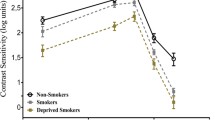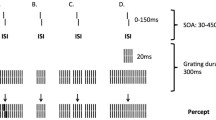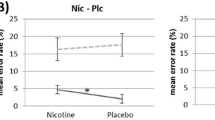Abstract
Two experiments investigating the effects of nicotine on performance in the inspection time (IT) procedure are reported. Experiment 1 compared ITs in smoking (0.8 mg nicotine cigarette), sham-smoking, and no-smoking conditions. IT was significantly shorter in the smoking condition as compared to both the no-smoking or sham-smoking conditions, suggesting that nicotine enhances early information processing. This result is of particular interest because of the correlation between IT and IQ reported in previous experiments. The nicotine related decrease in IT raises the possibility that nicotine enhances at least a subset of the physiological processes underlying intellectual performance. Experiment 2 examined the persistence of this nicotine related enhancement in IT, and investigated the effects of nicotine across 480 IT trials. Results suggested that ITs derived from the last third of the 480 trials were significantly shorter in the 0.8 mg cigarette condition than in no-smoking condition. The results from these two experiments, taken together with recent work examining the effects of nicotine on the string length measure of AEP waveform complexity and Hick decision time (DT), and studies investigating cognitive functioning and cholinergic system dysfunction in dementia, suggest a role of the cholinergic system in intellectual performance.
Similar content being viewed by others
References
Barrett P, Eysenck HJ, Lucking S (1986) Reaction time and intelligence: a replicated study. Intelligence 10:9–40
Bates T, Pellett O, Stough C, Mangan GL (1994) The effects of smoking on simple and choice reaction time. Psychopharmacology 114:365–378
Blinkhorn SF, Hendrickson DE (1982) Averaged evoked responses and psychometric intelligence. Nature 295:596–597
Brand C, Deary IJ (1982) Intelligence and “inspection time”. In: Eysenck HJ (ed) A model for intelligence. Springer, Berlin
Broks P, Preston GC, Traub, Poppleton P, Ward C, Stahl SM (1988) Modelling dementia: effects of scopolamine on memory and attention. Neuropsychologica 26:685–700
Caryl PG (1991) Evoked potentials, inspection time, and intelligence. Psychologist Bull Br Psychol Soc 4:537–541
Chaiken SR, Young RK (1993) Inspection time and intelligence: attempts to eliminate the apparent movement strategy. Am J Psychol 106:191–210
Deary IT (1993) Inspection time and WAIS-R IQ subtypes: a confirmatory factor analysis study. Intelligence 17:223–236.
Eysenck HJ (1987) Speed of information processing, reaction time, and the theory of intelligence. In: Vernon PA (ed) Speed of information processing and intelligence. Ablex, Norwood, N.J.
Eysenck HJ (1988) Editorial: the concept of IQ: useful or useless? Intelligence 12:1–6
Eysenck HJ, Barrett P (1985) Psychophysiology and the measurement of intelligence. In: Reynolds CR, Willson VL (eds) Methodological and statistical advances in the study of individual differences. Plenum Press, New York
Haier RJ, Robinson DL, Braden W, Williams D (1983) Electrical potentials of the cerebal cortex and psychometric intelligence. Person Indiv Diff 4:591–529
Hendrickson AE (1982) The biological basis of intelligence: Part II Measurement. In: Eysenck HJ (ed) A model for intelligence. Springer, Berlin Heidelberg New York
Hendrickson DE, Hendrickson AE (1980) The biological basis for individual differences in intelligence. Personality and Individual Differences 1:3–33
Jensen AR (1980) Chronometric analysis of intelligence. J Soc Bio Struct 3:103–122
Jensen AR (1982) Reaction time and psychometricg In: Eysenck HJ (ed) A model for intelligence. Springer, New York
Jensen AR (1987) Individual differences in the Hick paradigm. In: Vernon PA (ed) Speed of information processing and intelligence. Ablex, Norwood, N.J.
Jensen AR, Munro E (1979) Reaction time, movement time and intelligence. Intelligence 3:121–126
Juhel J (1991) Relationships between psychometric intelligence and information-processing speed indexes. Eur Bull Cogni Psychol 11:73–105
Kopelman MD (1987) How far could the cholinergic depletion account for the memory deficits of Alzheimer-type dementia or the alcoholic Korsakoff syndrome? In: Stahl SM, Iversen SD, Goodman EC (eds) Cognitive neurochemistry. Oxford University Press, Oxford, pp 303–326
Kranzler JH, Jensen AR (1989) Inspection time and intelligence: a meta-analysis. Intelligence 13:329–347
Lehrl S, Fischer B (1990) A basic information psychological parameter (BIP) for the reconstruction of concepts of intelleigence. Eur J Person 4:259–286
Mackenzie B, Cumming S (1986) How fragile is the relationship between inspection time and intelligence? The effects of apparent motion cues and previous experience. Person Indiv Diff 7[5]:721–729
Mangan GL, Golding J (1978) An “enhancement” model of smoking behaviour? In: Thornton RE (ed) Smoking behaviour: physiological and psychological influences. Churchill Livingstone, Edinburgh, pp 87–114
Matarazzo JD (1992) Psychological testing and assessment in the 21st century. Am Psychol 47:1007–1018
Nettelbeck T (1987) Inspection and intelligence. In: Vernon PA (ed) Speed of information processing and intelligence. Ablex, Norwood, N.J. pp 294–346
Nettelbeck T, Lally M (1976) Inspection time and measured intelligence. Br J Psychol 67:17–22
Petrie RXA, Deary IJ (1989) Smoking and human information processing. Psychopharmacology 99:393–396
Stough CKK, Nettelbeck T, Cooper C (1990) Evoked brain potentials, string length and intelligence. Person Indiv Diff 11 [4]:401–406
Stough C, Bates T, Mangan GL (1995) Smoking, string length and intelligence. Person Indiv Diff (in press)
Stough C, Bates T, Mangan GL, Colrain IC, Pellett O (in press) Inspection time and intelligence: Further attempts at reducing the apparent motion strategy. Intelligence
Vickers D, Smith P (1986) The rationale for the inspection time index. Person Indiv Diff 7:609–624
Vickers D, Nettelbeck T, Willson RJ (1972) Perceptual indices of performance: The measurement of “inspection time” and “noise” in the visual system. Perception 1:263–295
Warburton DM (1981) The neurochemistry of behaviour. BMJ 37:121–125
Wechsler D (1981) WAIS-R manual: Wechsler Adult Intelligence Scale-Revised. The Psychological Corporation, New York
Wenes, K, Warburton DM (1983) The effect of smoking on rapid visual information processing performance. Neuropsychobiology 9:223–229
Wesnes K, Warburton DM (1984a) Effects of cigarettes of varying yield on rapid information processing performance. Psychopharmacology 82:338–342
Wesnes K, Warburton DM (1984b) Effects of scopolamine and nicotine on human rapid information processing performance. Psychopharmacology 82:147–150
Widaman KF, Carlson JS, Saetemore CL, Galbraith GC (1993) The relationship of auditory evoked potentials to fluid and crystallized intelligence. Person Indiv Diff 15:205–218
Author information
Authors and Affiliations
Rights and permissions
About this article
Cite this article
Stough, C., Mangan, G., Bates, T. et al. Effects of nicotine on perceptual speed. Psychopharmacology 119, 305–310 (1995). https://doi.org/10.1007/BF02246296
Received:
Revised:
Issue Date:
DOI: https://doi.org/10.1007/BF02246296




